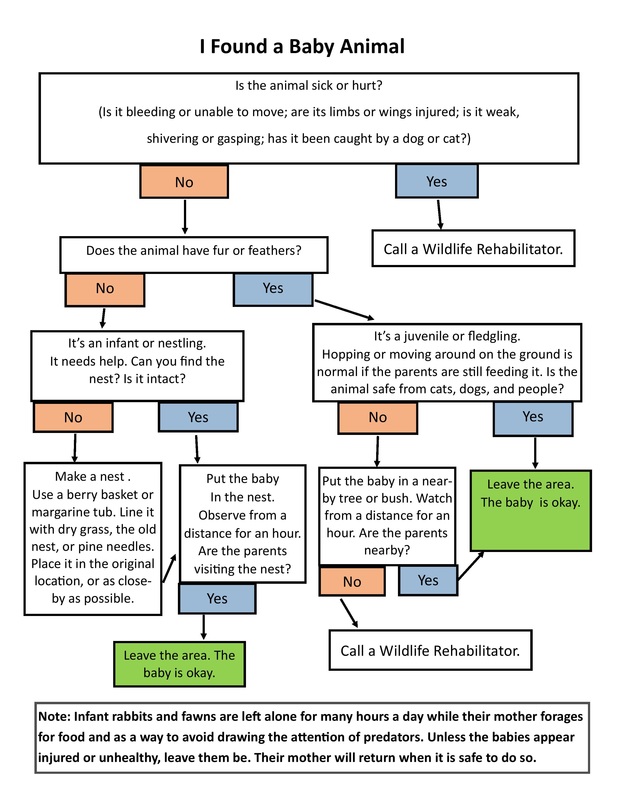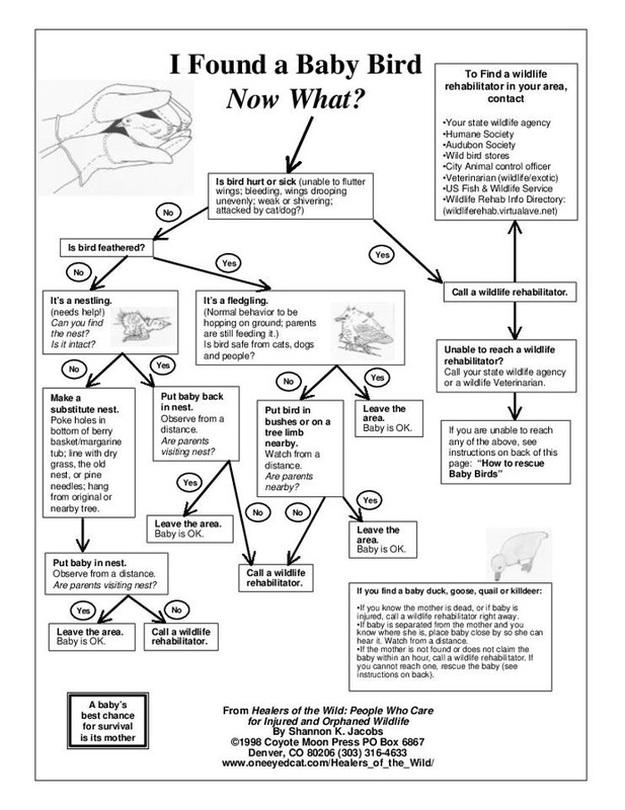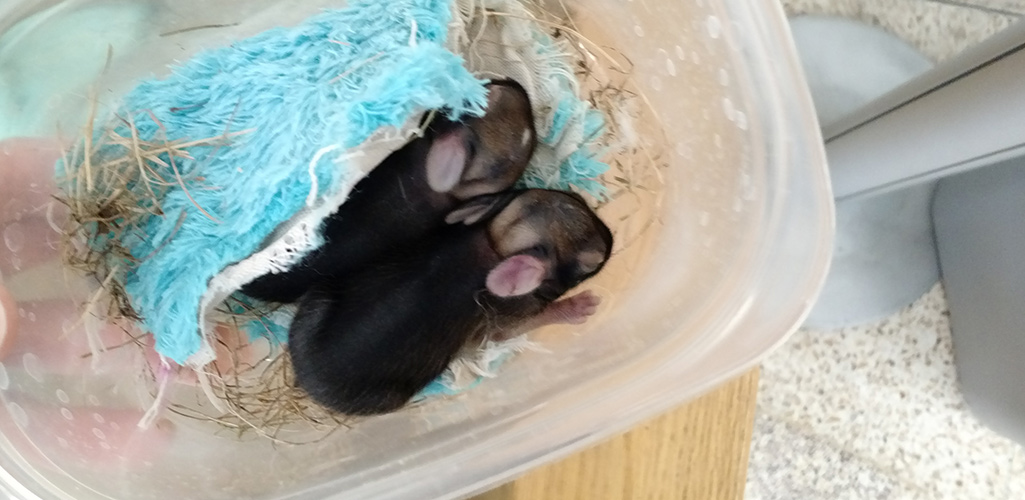Spring is the time of the year when animals start having babies and it is also the time of the year when animal rehabilitation centers start receiving calls about orphaned wild animals.
It is only natural for people to want to help animals if they appear to be in need but most of the time the animal is not in any danger and it is better to leave them alone. You may have heard about the bison calf that was “rescued” by tourists visiting Yellowstone National Park and that later the bison calf was humanely euthanized by the park rangers due to human interference. I hope that by reading this that you may have a better idea of what to do should you come across a wild baby animal.
The parental strategy of many wild animals is to hide away their young in a nest in order to keep them safe from other animals. Rabbits, deer, and squirrels leave their young alone most of the day and so it may appear as though their young are abandoned. These animals’ young have a strong instinct to stay put and not move in order to not draw attention to their location. If you happen to stumble across a nest of baby animals or even an individual baby animal, the best thing you can do is to assess the situation before assuming that they are abandoned. Use the following flow charts from the Blue Heron nature preserve in order to assess whether or not that baby animal needs help.

 Images retrieved from Blue Heron Nature Preserve
Images retrieved from Blue Heron Nature Preserve
There are many myths surrounding baby wild animals that I hope to shed some light on.
Myth #1: Fawns that are seen alone are abandoned.
Fact: It is a common thing to see fawns hunkered down in tall grass or in other areas that their mother has determined to be a safe location to hide from predators. Fawns are born without a strong scent and since they are not able to run fast before the age of 4 weeks-old, their best survival strategy is to stay perfectly still as to not bring attention to themselves. The doe will visit the fawn a few times a day to provide an opportunity for the fawn to feed. The fawn’s spots serve as natural camouflage and so if you come across a fawn, it is best to leave it alone. If you are certain that the mother has died or if the fawn is crying constantly than you should contact your nearest wildlife rehabilitation center for instructions on what to do.
Myth #2: Baby bunnies have been abandoned.
Fact: Just like with fawns, young rabbits are purposefully hidden in a nest in order to protect them from predators. Mother rabbits only visit their babies a few times a day in order to lessen the chance of them being discovered by roaming predators. If you stumble across a nest of rabbits and the nest hasn’t been disturbed, it is best to leave them alone. Rabbits are much more sensitive to smells than other animals and are more likely to abandon their young if their nest is disturbed. If the babies still have their eyes closed and if the nest has been disturbed by a wild animal, pets, or by people, there is still a chance that the mother will continue to care for them if you can place them in a safe location. If you need to move their nest, the best thing is to avoid rubbing your scent on the young by using towels or gloves to pick them up. Make sure to move the nesting material from the old nest and into the new nest in order to provide the best chance for the mother to find her babies. If the babies have their eyes open there is a good chance that you don’t need to do any interfering since at this age the young are less vulnerable. But if you are concerned that they will be harmed by pets or by people, it is best to contact your nearest rehabilitation center.
Myth #3: If your scent rubs off onto a baby bird, it will become abandoned.
Fact: Birds have a much more limited sense of smell than compared to many other animals and so birds almost never abandon their chicks after human handling. If you come across a baby bird that has little to no feathers, the best thing to do is to locate the nest and place the baby back. If you cannot find the nest the next best thing would be to create a substitute nest and place it in a safe location above the ground so that the parents can return to care for it. A good nest substitute could be using a basket or a shallow plastic container (with small holes punched into the bottom to prevent water from collecting in the container) that can be tacked up in a tree and filling it with grass and nesting materials (make sure that the container isn’t too deep because birds are reluctant to fly into anything they cannot see out of). If the baby bird is fully feathered, is clearly learning how to fly, and is not in immediate danger from cats or dogs, it is best to leave it alone. Its parents will continue to care for it even on the ground as it learns how to fly. If none of these scenarios are possible than contact your nearest rehabilitation center for more information.
Myth #4: You should feed an orphaned animal that has been rescued.
Fact: Most baby wild animals have a very specific diet and you can cause more harm than good. The baby may be in shock or may end up aspirating if you don’t know what you are doing when trying to feed them. The best thing to do is to call your nearest rehabilitation center for information on what to do.
Myth #5: If you raise a baby wild animal it will make a good pet.
Fact: Even if you managed to successfully raise a wild animal from a baby, not only is it illegal in most places, it is never a good idea. Once a wild animal reaches sexual maturity it’s wild instincts almost always take over. It will become more aggressive and will have the goal of mating, reproducing, and surviving.
Have you ever found a baby animal? What did you do? Please share your photos and stories by visiting the Urban Wildlife Alliance’s Facebook page!
I have listed out some resources below to help you out if you still need more information about how to find your nearest rehabilitation center as well as more information on wild baby animals.
Click HERE to locate your nearest wildlife rehabilitation center.
Click HERE for more information about what to do when you find wild animals.
REFERENCES
BCSPCA. (2014, March 25). 10 common wildlife myths debunked. Retrieved from The British Columbia Society for the Prevention of Cruelty to Animals: http://www.spca.bc.ca/news-and-events/news/common-wildlife-myths-debunked.html
Brulliard, K. (2016, May 16). Baby bison dies after Yellowstone tourists put it in their car because it looked cold. Retrieved from The Washington Post: https://www.washingtonpost.com/news/animalia/wp/2016/05/16/baby-bison-dies-after-yellowstone-tourists-put-it-in-their-car-because-it-looked-cold/?utm_term=.9701387ee80d
OAHS. (2016). Wildlife. Retrieved from Oshkosh Area Humane Society: https://www.oahs.org/wildlife
Sparks, B., & Casey, S. J. (1998). Reuniting Young Wild Mammals with their Mothers. Journal of Wildlife Rehabilitation, 21, 3-8.
